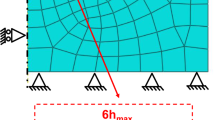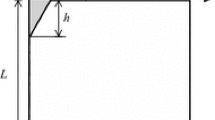Abstract
Lee and Radok [J. Appl. Mech.27, 438 (1960)] derived the solution for the indentation of a smooth rigid indenter on a linear viscoelastic half-space. They had pointed out that their solution was valid only for regimes where contact area did not decrease with time. In this article, a large number of finite element simulations and one typical experiment demonstrate that Lee-Radok solution is approximately valid for the case of reducing contact area. Based on this finding, three semiempirical methods, i.e., Step-Ramp method, Ramp-Ramp method and Sine-Sine method, are proposed for determination of shear creep compliance using the data of both loading and unloading segments. The reliability of these methods is acceptable within certain tolerance.










Similar content being viewed by others
References
W.C. Oliver and G.M. Pharr: An improved technique for determining hardness and elastic modulus using load and displacement sensing indentation experiments. J. Mater. Res. 7, 1564 (1992).
A.H.W. Ngan and B. Tang: Viscoelastic effects during unloading in depth-sensing indentation. J. Mater. Res. 17, 2604 (2002).
G. Feng and A.H.W. Ngan: Effects of creep and thermal drift on modulus measurement using depth-sensing indentation. J. Mater. Res. 17, 660 (2002).
B. Tang and A.H.W. Ngan: Accurate measurement of tip–sample contact size during nanoindentation of viscoelastic materials. J. Mater. Res. 18, 1141 (2003).
Y.T. Cheng and C.M. Cheng: Relationships between initial unloading slope, contact depth, and mechanical properties for spherical indentation in linear viscoelastic solids. Mater. Sci. Eng. A 409, 93 (2005).
Y.T. Cheng and C.M. Cheng: General relationship between contact stiffness, contact depth, and mechanical properties for indentation in linear viscoelastic solids using axisymmetric indenters of arbitrary profiles. Appl. Phys. Lett. 87, 111914 (2005).
Y.T. Cheng, W.Y. Ni, and C.M. Cheng: Determining the instantaneous modulus of viscoelastic solids using instrumented indentation measurements. J. Mater. Res. 20, 3061 (2005).
Y.T. Cheng, C.M. Cheng, and W.Y. Ni: Methods of obtaining instantaneous modulus of viscoelastic solids using displacement-controlled instrumented indentation with axisymmetric indenters of arbitrary smooth profiles. Mater. Sci. Eng. A 423, 2 (2006).
H. Lu, B. Wang, J. Ma, G. Huang, and H. Viswanathan: Measurement of creep compliance of solid polymers by nanoindentation. Mech. Time-Depend. Mater. 7, 189 (2003).
M.L. Oyen: Spherical indentation creep following ramp loading. J. Mater. Res. 20, 2094 (2005).
M.L. Oyen: Analytical techniques for indentation of viscoelastic materials. Philos. Mag. 86, 5625 (2006).
C.A. Tweedie and K.J. Van Vliet: Contact creep compliance of viscoelastic materials via nanoindentation. J. Mater. Res. 21, 1576 (2006).
G. Huang and H. Lu: Measurements of two independent viscoelastic functions by nanoindentation. Exp. Mech. 47, 87 (2006).
M. Vandamme and F. Ulm: Viscoelastic solutions for conical indentation. Int J. Solids Struct. 43, 3142 (2006).
G. Huang and H. Lu: Measurement of Young’s relaxation modulus using nanoindentation. Mech. Time-Depend. Mater. 10, 229 (2007).
J. Mencík and L. Beneš: Determination of viscoelastic properties by nanoindentation. J. Optoelectron. Adv. Mater. 10, 3288 (2008).
Y.T. Cheng and F.Q. Yang: Obtaining shear relaxation modulus and creep compliance of linear viscoelastic materials from instrumented indentation using axisymmetric indenters of power-law profiles. J. Mater. Res. 24, 3013 (2009).
E.H. Lee and J.R.M. Radok: The contact problem for viscoelastic bodies. J. Appl. Mech. 27, 438 (1960).
S.C. Hunter: The Hertz problem for a rigid spherical indenter and a viscoelastic half-space. J. Mech. Phys. Solids 8, 219 (1960).
G.A.C. Graham: The contact problem in the linear theory of viscoelasticity. Int. J. Eng. Sci. 3, 27 (1965).
T.C.T. Ting: Contact stresses between a rigid indenter and a viscoelastic half-space. J. Appl. Mech. 33, 845 (1966).
J.A. Greenwood: Contact between an axisymmetric indenter and a viscoelastic half-space. Int. J. Mech. Sci. 52, 829 (2010).
ABAQUS (HKS Inc, Pawtucket, RI).
Acknowledgments
The authors would like to thank Prof. Y-T. Cheng for helpful discussion. The support from NSF of China (Project No. 11025212, 10872200, 11172305, 11021262) is also gratefully acknowledged.
Author information
Authors and Affiliations
Corresponding author
Rights and permissions
About this article
Cite this article
Peng, G., Zhang, T., Feng, Y. et al. Determination of shear creep compliance of linear viscoelastic solids by instrumented indentation when the contact area has a single maximum. Journal of Materials Research 27, 1565–1572 (2012). https://doi.org/10.1557/jmr.2012.120
Received:
Accepted:
Published:
Issue Date:
DOI: https://doi.org/10.1557/jmr.2012.120




